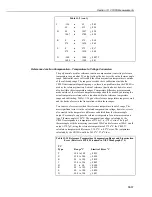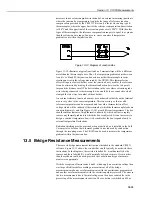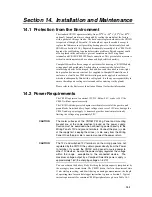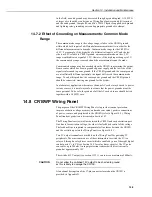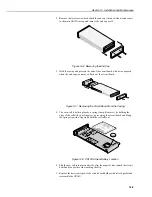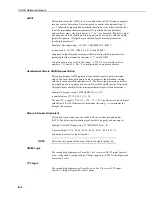
Section 14. Installation and Maintenance
14-5
In the field, an earth ground may be created through a grounding rod. A 14 SWG
or larger wire should be run between a Wiring Panel power ground (G) terminal
and the earth ground. Campbell Scientific’s CM10 Tripod is supplied with ground
and lightning rods, grounding wires and appropriate ground wire clamps.
14.7.2 Effect of Grounding on Measurements: Common Mode
Range
The common mode range is the voltage range, relative to the CR10X ground,
within which both inputs of a differential measurement must lie in order for the
differential measurement to be made. Common mode range for the CR10X is
±2.5V. For example, if the high side of a differential input is at 2V and the low
side is at 0.5V relative to CR10X ground, a measurement made on the ±2.5V
range would indicate a signal of 1.5V. However, if the high input changes to 3V,
the common mode range is exceeded and the measurement cannot be made.
Common mode range may be exceeded when the CR10X is measuring the output
from a sensor which has its own grounded power supply and the low side of the
signal is referenced to power ground. If the CR10X ground and the sensor ground
are at sufficiently different potentials, the signal will exceed the common mode
range. To solve this problem, the sensor power ground and the CR10X ground
should be connected, creating one ground for the system.
In a laboratory application, where more than one AC socket may be used to power
various sensors, it is not always safe to assume that the power grounds are at the
same potential. To be safe, the ground of all the AC sockets in use should be tied
together with a 14 SWG wire.
14.8 CR10WP Wiring Panel
The purpose of the CR10WP Wiring Panel is to provide transient protection,
improve excitation voltage accuracy, and make convenient, positive connections
of power, sensors, and peripherals to the CR10X (refer to Figure 14-2). Wiring
Panel transient protection is discussed in Section 14.7.
The Wiring Panel carries two lines between the CR10X and each excitation port.
One line is for excitation voltage, the other is for feedback control of the voltage.
The feedback line is required to compensate for line losses between the CR10X
and the excitation port on the Wiring Panel (see Figure 14-2).
Two 5V output terminals are available on the Wiring Panel for powering 5V
peripherals. The most common use of these terminals is to switch the 5V to a
relay coil through a relay driver circuit which is enabled by one of the eight digital
control ports, C1 to C8 (see Section 14.9 for relay driver circuits). The 5V ports
can source up to 200mA. An input protection transzorb will divert current to
ground at approximately 10V.
The switched 12V output (see section OV1.1) can source a maximum of 600mA.
Do not allow the switched 12V output to be shorted to ground,
as this is likely to damage the CR10X.
A functional description of the 37-pin connector located on the CR10X is
provided in Appendix D.
CAUTION

